RAMify: The Curse of Undying Memory
Forgetting, VR, and Contemporary Cyberpunk
Don't own a VR headset yet? Don't worry! VIEW the full gameplay HERE!
Video Demo
Abstract
RAMify is an interactive VR storytelling experience that revolves around futuristic technology for memory editing and removal. From written language to photography, human culture has long relied on external tools for storing personal and societal memory. With the ascent of digital culture and its capacity for seamless archiving, not only has the effectiveness of these tools increased but, as some scholars argue, the human behavioral default has shifted from forgetting to remembering. RAMify intends to explore the ramifications of future memory technologies.
The story of RAMify takes place in a cyberpunk society, where memory implants and memory retrieval technologies have become commonplace. The player plays as a memory architect working for the MindGen Corporation, currently tasked with fulfilling a dying woman’s last wish of recovering the memory of her long-lost son. In the course of gameplay, the player must face complex ethical questions about whether to preserve, alter or delete the memories, as they uncover the relationship between the mother and the son. RAMify’s narrative immersion is delivered through a combination of the Passthrough AR feature and VR to stimulate the player's imagination based on reality.
Though set within the convention of the futuristic cyberpunk genre, RAMify addresses already existing dilemmas around technology and memory. Within the interactive experience, the ability to navigate through an individual’s memory represents the possible future of memory externalization. Exploring both the positive and negative ramifications of hypothetical memory tech, it rejuvenates the concern of the cyberpunk genre in a distinctly contemporary setting, highlighting the choices we make when using our technologies in order to remember or forget.
Through showing the possible consequences that memory over-externalization would bring to individuals and society in the future era, my project would raise people’s awareness on remembering to forget, and therefore avoid the dystopian cyberpunk scenario that the lack of forgetting would forge.
Inspiration
From literatures ...
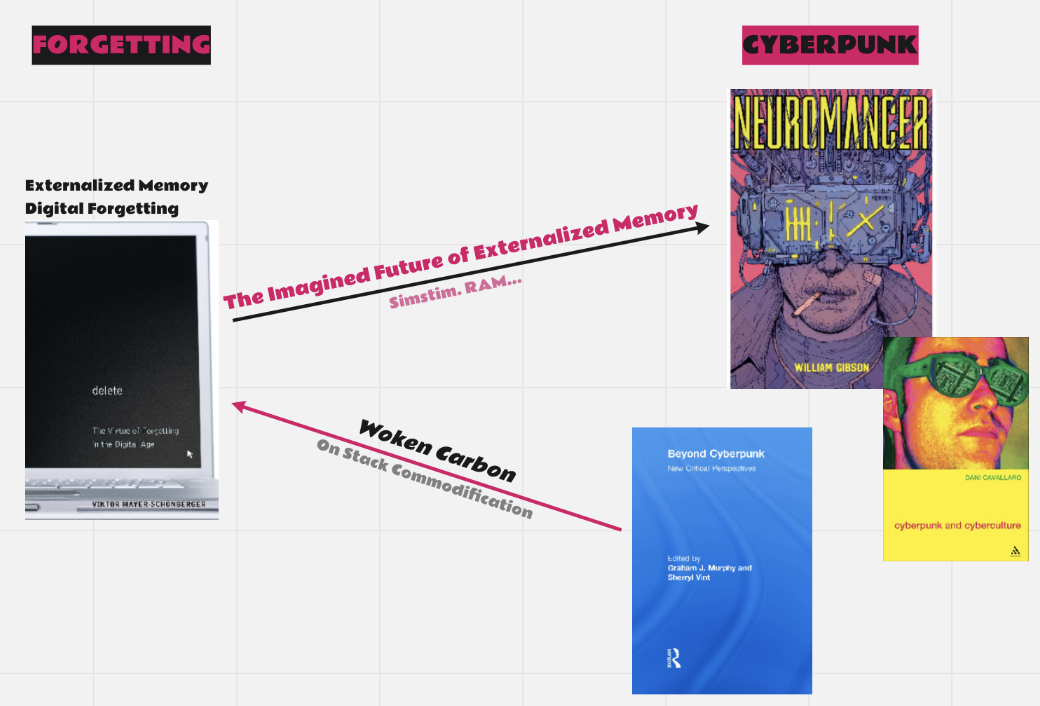
Contemporary studies on cyberpunk culture and visions inherit the tradition of picturing a dystopian futuristic society and derive new imaginations from the inventions created in past works of the genre. Although we are witnessing a cyberpunk revival in works of different genres (fictions, video games, etc.), the retro-futuristic references to works like Neuromancer ignore the by-product that has been unearthed along with the birth of modern technologies. These existing side-effects, particularly the loss of forgetting caused by memory over-externalization, are necessary factors to be considered when constructing an up-to-date contemporary imagination for cyberpunk.
... to Mass Media
My case studies consist of three video games and a VR project: To the Moon, Cyberpunk 2077, The Last Night, and Their Memory.
In To the Moon, the player plays as one of the two doctors who tries to implant a memory of “traveling to the moon” into an old man’s memory to fulfill his dying wish. Even though it is a 2011 PC game and its aesthetic isn’t considered cyberpunk style, I learned how they distinguish the same scene in reality from memories purely through blurring the edges and making the color tone yellowish in the memory. After I implemented the idea into the old man’s memory, I had to connect his memory tubes that would initiate a series of changes in his consequent memories, this inspired me when designing the “butterfly effect” that would happen when deleting or altering the woman’s memory.
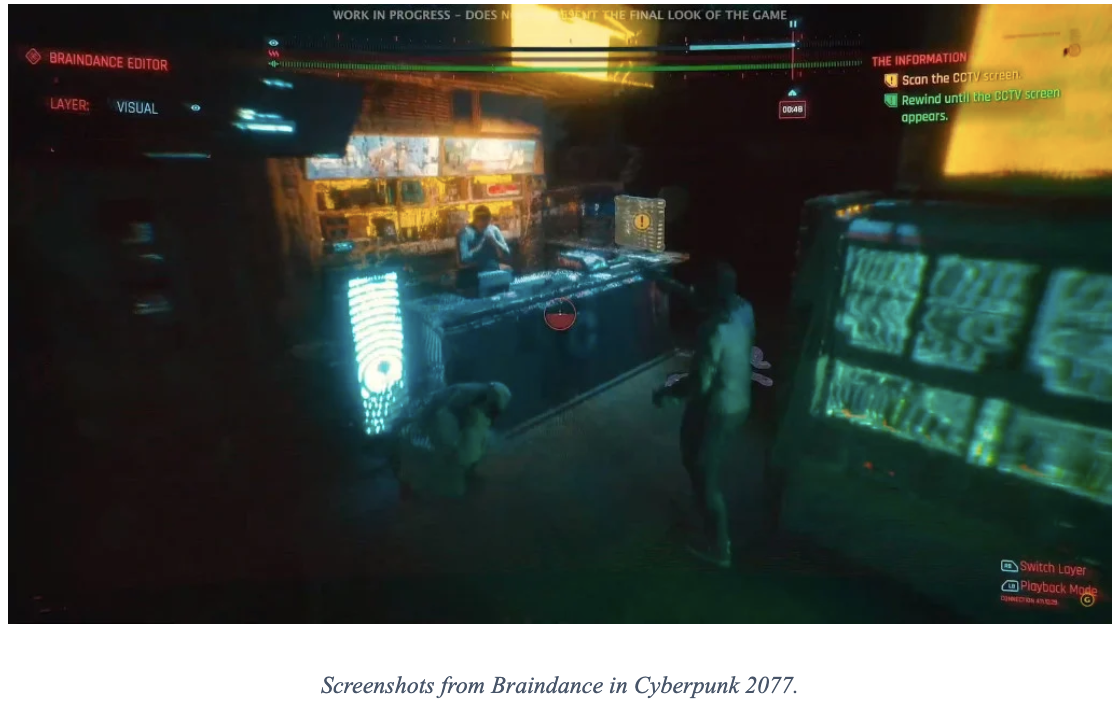
“Braindance” is an implanted memory recording device that appeared repeatedly in Cyberpunk 2077, the footage processing techniques that were used in displaying “braindance” footage can be implemented in the woman’s memory clips.
What is Memory Over-externalization?
I was introduced to the long history of memory-externalization from Delete: The Virtue of Forgetting in the Digital Age. The idea of using external tools to assist in storing personal and societal memory has existed for more than recent decades. Ever since the very beginning, human beings have used language, paintings, and writings to keep logs for our memory. But it wasn't until the beginning of the digital era when we encountered the problem of memory over-externalization as more effective tools came to life: inventions like hard disks made cheap storage a reality, allowing human beings to preserve the gigantic amount of information we generate. When space is no longer a constraint, our behavioral default regarding external memory would be altered from forgetting to remembering. A simple example would be uploading photos from our phone to the computer. After connecting the two devices, we are often asked if we would like to "select photos to upload" or "upload all". Now we could spend 15 minutes or more manually selecting the photos that are worth looking at again to upload, but it would only take us less than one second to click on the "upload all" button, sit back and let the technology work its own magic. Considering the cost of time, the extra cost of space in the "upload all" method can be completely ignored. In other words, forgetting has become too expensive for us and remembering too cheap.
Schönberger’s views on how modern technologies become a barrier for people to forget inspire me to ponder the questions:
- Will the demise of forgetting to grow into a more severe situation in the long run?
- How will the development of future memory externalizing tools influence the act of forgetting?
Design and Technical Highlights
Pre Unity
Scene Logic Map
Being an interactive experience with multiple branches that lead to different outcomes, I started off creating a logic map that links together all the scene nodes that will be included in the game.
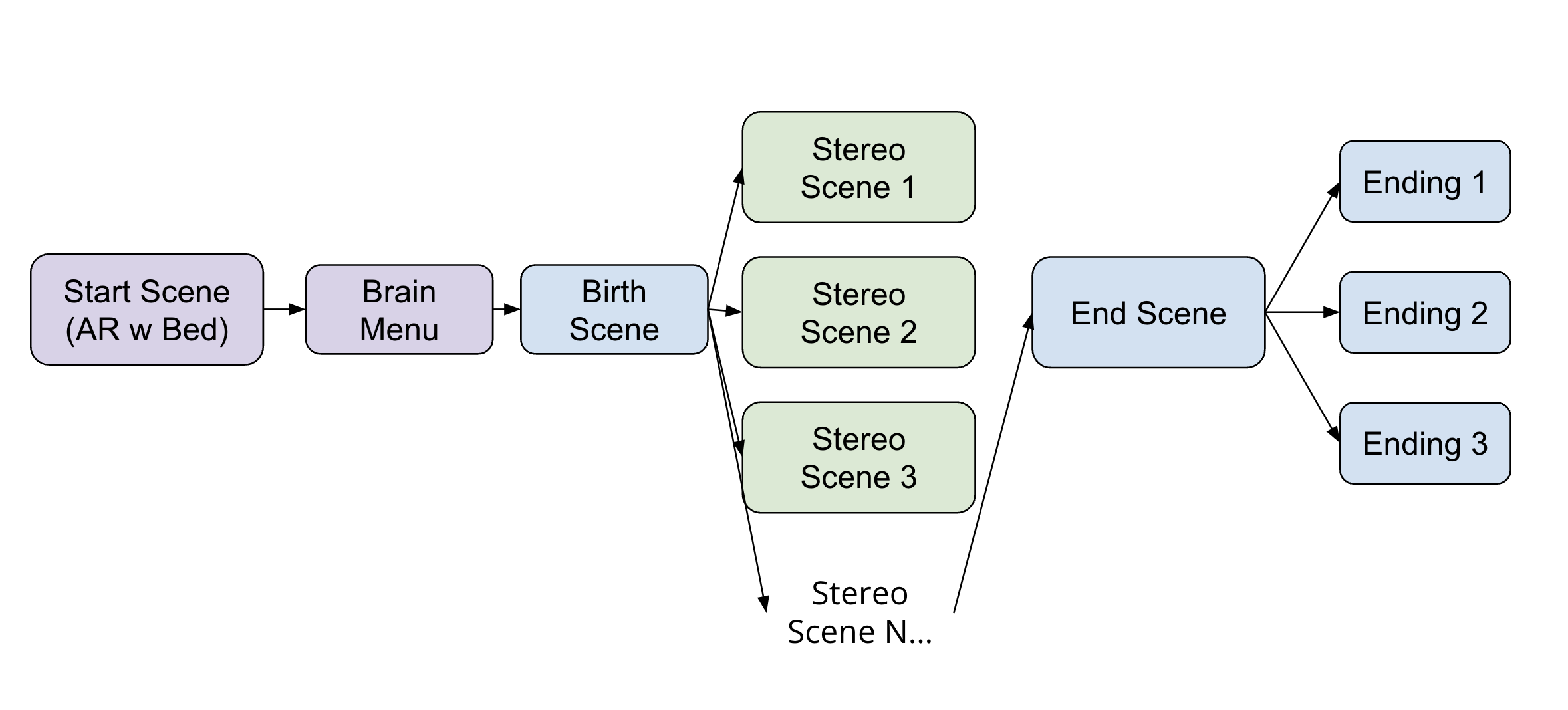
Script Writing
RAMify is a strong narrative game. With no voiceovers, the lines in game needs to be refined to "casual and daily" terms, and scenario-fitting tones to cope with the relax, desperate, or even horrifying scenes in game.
I borrowed some terms from Ganster Talk Translator

Mid Unity
Passthrough Feature
Originally, I planned to implement my virtual environment on the real-life environment layer, and purchase a physical ward bed to simulate the ward environment. With the project being completely virtual now due to Shanghai's lockdown situation, I had to place a ward model in the virtual environment.
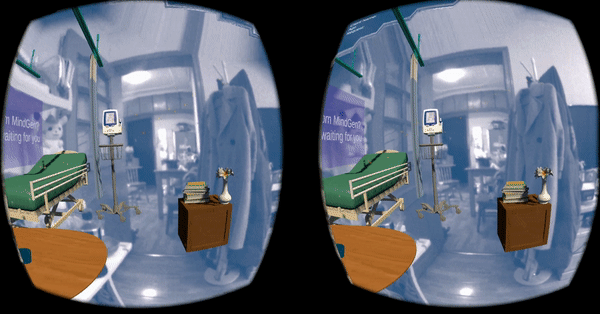
VFX SDF
To develop a futuritic and high-tech brain scene, I planned to generate fluid particles to form my brain and neuron models.
I experimented with the Signed Distance Field in VFX and it gave me a nice result overall:


Button-controlled Color Lerp
When at the end of the game, the player needs to make their final decision by holding onto a button and watch how their decision impact their client. To emphasize on the "butterfly effect" caused by memory editing, I designed a button that the player needs to hold onto in order to complete the operation. The color of the Brain and Neuron would also slowly lerp to another color as the button is being pressed; and lerp back to the original state if the button is released in the middle:
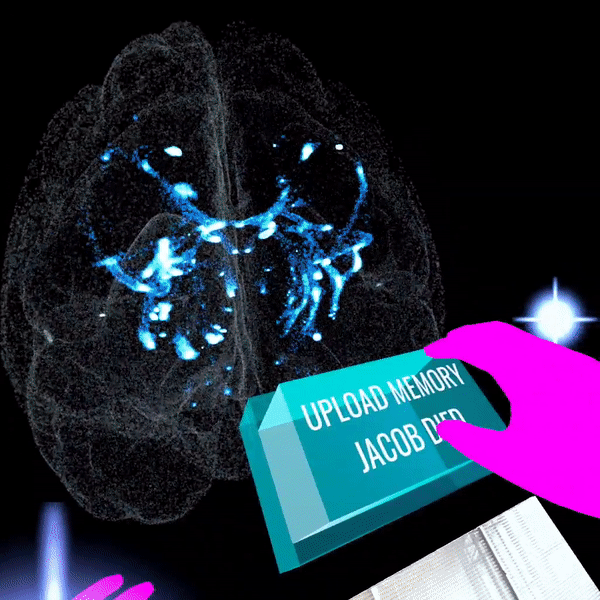
Stereo Narration Scene
This stereo scene place an important role in the narration. To have the player focus on the story itself and the cultural settng of the game, I shrank the visual elements of this scene down to the four main objects that emits sound. In addition to the stereo sound on multiple sound sources, many sound sources are animated to simulate an even more immersive environment for the experience.
Here, player not only learns about Jacob's intention, but also gets to know how people living in that era freqently deal with memory technologies and entertainment.
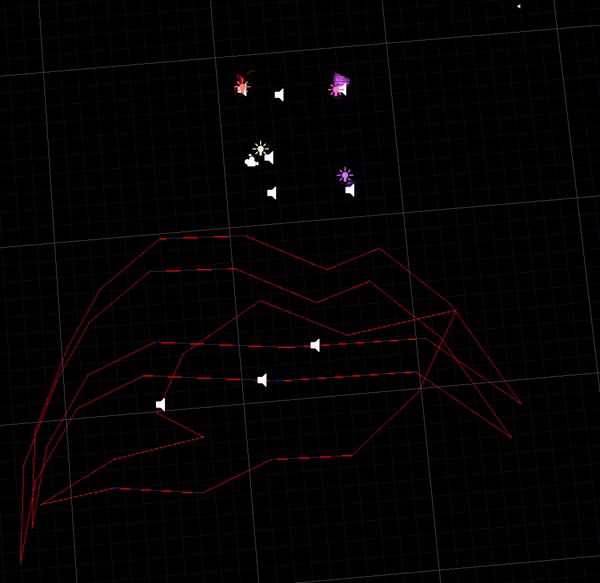
Fix Memory Operation
As a memory architect, the player need retrieve lost memory of the client. To simulate this operation, all unfixed memory scenes are covered with blurry shader until the whole scene is fixed.
There are several object that needs to be fixed in a certain order, particles with specific waypoints sets are used to link one memory object to another.
I simulated the memory fixing operation through gradually changing the opacity of the material's texture of the memory objects; once the object is fixed, it will become opague, its animation will also start playing.
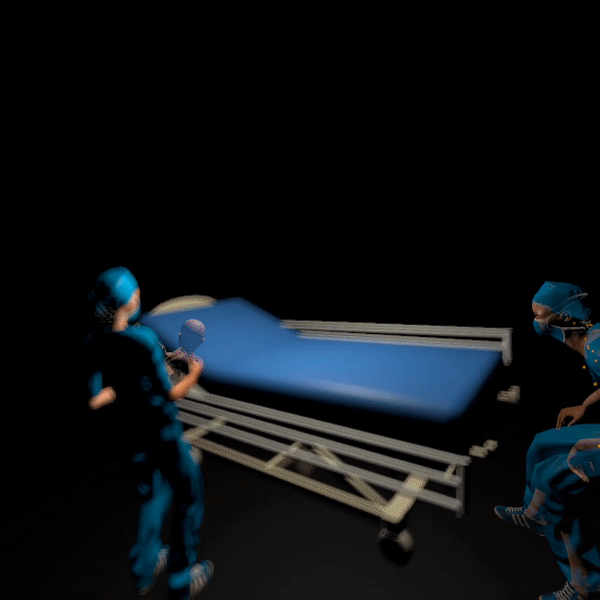
Reference List
Tutorials
- How To Setup The Passthrough API With Oculus Quest 2 ?
- How to make Blur in Unity URP ShaderGraph
- Unity VFX Graph Tutorial How to bake SDF and use in Visual Effect Graph
- [Unity] VR Button Press using XR Toolkit
- How to Setup XR Toolkit's Action-Based Input in Unity
3D Models
- Human Brain
- Skull and Nerve System
- Hospital Bed
- Hospital Bed with Wheels
- Flowers In Vase
- Nurse
- Enfant
- Security Guard
Sound Effects and Music
- Brain Menu Background Music - Zihan Feng
- End Game Background Music - Zihan Feng
- Frying and Deep-frying Sound Effect
- Footsteps Sound Effect
- Car Driving Away Sound Effect
- Newborn Baby First Voice
- Kelly's ICU Sounds
Special Thanks to...
Anna Greenspan, Bogna Konior, Stavros Didakis, Jingtian Zong, Xingchen Zhang for instructions and supports
Zihan Feng for music compositions
NYU Shanghai IMA family for staying strong together through the lockdown period!